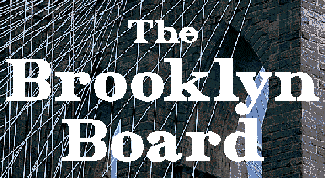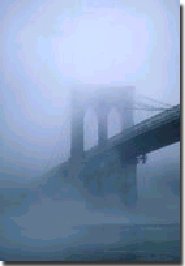
For displaced, misplaced, and nostalgic ex-Brooklynites |
|
On the Naming of The Brooklyn Bridge T he decision to build a major bridge across the East River between Manhattan and Brooklyn was very significant. All believed the need existed, for sometimes selfish reasons, but there were both major and minor obstacles. There were no suspension bridges of the proposed size in existence; the cost would be tremendous; there were multiple corrupt and honest politicians to contend with; unions and interest groups would have to be placated; technologies would have to be dreamed and developed. Additionally, it seemed everyone with a mouth had an opinion that had to be addressed. Over the years some things have not changed. It was believed that all these could be successfully overcome, yet one issue remained: what should "The Bridge" be officially named and known as. Manhattan believed it needed Brooklyn as it expanded. Lower Manhattan had come out of the Civil War as a major industrial complex cramped by watered boundaries and by a layout that limited growth. They needed expansion room and a major infrastructure tie to the city of Brooklyn was viewed as a logical and economic necessity. Brooklyn needed the bridge to enable its residents to get to work and as a way to easily transport raw materials and finished goods to and from Manhattan's shipping capabilities. They believed that if "The Bridge" were built it would only be a short time before Brooklyn was the major locale and Manhattan would become either an outlying industrial complex or a mere suburb to metropolitan Brooklyn. For Brooklynites, and those with the resources, there was the possibility of vast enrichment through real estate speculation and development. The newspapers of the two cities were in the thick of things. They were constantly trying to outdo each other in promoting their own city's position on "The Bridge". They did not limit their own activities to self-promotion; they were continually reporting and editorializing on the shortcomings and lunacy of the other city's positions and promulgations. The papers had worked their respective populaces into a near frenzy of excitement in support of their bridge, "The Bridge". Though "The Bridge" was proposed prior to the Civil War, the New York State Legislature did not approve a bill for the construction of an East River crossing until 1866. President Ulysses S. Grant signed a bill approving the bridge plan in 1869, but still there was a major decision to be made that would have ramification to this day. Simply put, "The Bridge" must have an appropriate name. The power elite of both cities, Manhattan and Brooklyn, convened at Governor's Island in New York harbor, a more or less neutral site, in May, 1868, to address "The Name". There, 170 select commissioners plus aids, scribes, reporters, security, and common folk met to confront naming "The Bridge. In all, over 500 attended. And with the reporters there, every individual saw an opportunity to get their positions and feeling heard and reported to their constituents, friends, or families. Possibilities for "The Name" seemed endless and included presidents, geographic areas, Indian names, saints, historic figures and national leaders, explorers, and even attributes such as Hope and Faith. Everyone seemed to have strongly held ideas and opinions. Note that there were Manhattanites who wanted "The Bridge" to be "The Brooklyn Bridge" as "bridge to Brooklyn", which they felt would reflect their city as in a superior position. A similar but converse stand was taken by some Brooklynites who wanted a "bridge to Manhattan". After three weeks of speeches, reports, discussions, debates, and a few fist fights, the "Governor's Island Grousers", as they had become to be known, were no closer to reaching a decision on "The Name" than when they had begun. No one was happy and everybody was frustrated. A young page, Charlie O'Neill, working at the gathering, developed an idea, wrote it up, and passed it to James S. Richmond, municipal observer from Staten Island for consideration and presentation to the Chairperson. In his lowly position, Mr. O'Neill could not make the proposal himself and have it seriously considered. Charlie proposed that they get the number of possibilities down to a few, have advocates for each name prepare a report and presentation reasoning for their choice of "The Name", and that they reconvene in three months time to hear a two hour presentation and for the commissioners to immediately vote on "The Name". After all the weary weeks of work the idea was accepted and the candidate names pared to three: Brooklyn, East River, and Manhattan. The East River name was subsequently eliminated when the chief proponent of the name was found in a compromising position with two of the helpers on the Governor's Island ferry. The selection became between the two: The Brooklyn Bridge and The Manhattan Bridge. The Brooklyn team went into seclusion and worked feverishly. They brought in historians, philosophers, and representatives of the religious communities, the various nationalities, and bankers, merchants, and manufacturers. Poets and writers of the age were called upon for input. Politicians, educators, and engineers contributed. Their work was noble and they were so proud of their efforts. Scribes and artists were recruited to add flair, dignity, and polish. The Manhattan team started off strong but after three weeks of work they seemed to lose interest. They continued to meet but their fire seemed out. This was reported by spies to the Brooklyn Team and it raised their spirits, hopes and expectations. The three months passed quickly and at the date and time for the presentations, the commission members were all present and the teams seemed ready. The hall was packed and everyone was excited. In deference to alphabetical order, the Brooklyn team went first. After the initial introduction, the chairman for the Brooklyn team, Prospect Kingsman, presented three bound volumes, over 1,000 pages, for "The Bridge" to be The Brooklyn Bridge. A fifty member chorus then came up and sang a new composition in praise of the glories of Brooklyn. Following was an historian speaking of Brooklyn's past and current grandness. This was followed by an economist addressing the futures of Brooklyn, Manhattan, and Long Island and showing how Brooklyn alone would absolutely take the leadership role. The closing was by a renowned homilist and orator who spoke with flourish, passion, and logic. He closed just at the end of his two hour allotted time by shouting up to the heavens, "and for this and all that is right and good and wonderful in God's eyes, "The Bridge" should be forever known as The Brooklyn Bridge." The hall erupted with cheers and applause. There was pandemonium. Even the Manhattan team was impressed and cheered. Back-slapping, hand-shaking, and sincere congratulations were everywhere.
After ten minutes, the audience was gaveled to order by the Chairperson, C. M.
Resolvit. She demanded appropriate order, decorum, and attention as she
invited the Manhattan team to present.
A sole individual, Nicholas Bocker, approached the chairperson, handed her a single sealed envelope, and stepped to the podium. The hall fell silent. His words, as recorded: "Madam Chairperson, members of the committee, respected members of the Brooklyn team, distinguished governmental representatives, honored guests, members of the press, fellow citizens, women and children. On behalf of the great city of Manhattan, we have carefully and meticulously reviewed and scrutinized John A. Roebling's engineering plans for the proposed bridge over the East River. We have evaluated the design, the river bed soil samples, the swift and turbulent currents, and wind patterns. We have delved deeply into the economics of "The Bridge". Our work was both complete and comprehensive. The wondrous and glorious city of Manhattan believes "The Bridge" will not stand and wishes not to be associated with it. We defer and recommend that "The Bridge" be called The Brooklyn Bridge. Thank you for your time and attention." And so it was and for all times hence known as The Brooklyn Bridge. Construction was begun in 1870 and The Brooklyn Bridge was opened on May 24, 1883. 119 years later, Manhattan still foolishly stands by its decision.
"Brooklyn Bridge in Fog I" image courtesy of Denton Taylor
|
Copyright ©2002-2025 SofTech Consulting, Chappaqua, New York, USA All Rights Reserved.
